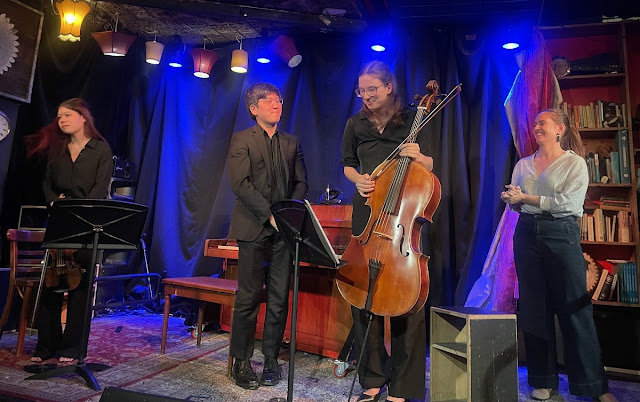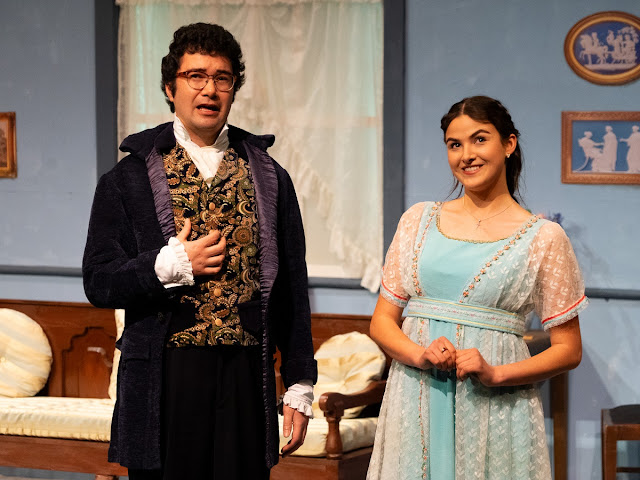by Tony Magee
This was the exclamation a man sitting next to me made, when I asked him, at interval, if he was enjoying the show.
Well, at least he got the composer right.
The Royal Czech Ballet’s final Canberra performance of Tchaikovsky’s “Sleeping Beauty” on September 18 at The Canberra Theatre was enjoyable, although not peppered with any really outstanding moments or sequences of thrilling ballet dancing, save for male principle soloist Nikolay Nazarkevich as Prince Desire performing a stimulating and impressive short solo sequence around the stage towards the end of Act II - something he received very enthusiastic and appreciative applause for.
 |
Nikolay Nazarkevich as Prince Desire and Natalia Kusheh as Princess Aurora in Sleeping Beauty.
Photo courtesy Royal Czech Ballet |
Having said that, there were still some very nice choreographic moments, and some strong dancing.
Approached in 1888 by director of the Imperial Theatres in St. Petersburg, Ivan Vsevolozhsky, Tchaikovsky conceived the score that same year, the final orchestrations being completed in 1889. Choreographer Marius Petipa wrote a very detailed list of instructions as to the musical requirements for Sleeping Beauty. Originally a prologue followed by three acts, this version by The Royal Czech Ballet was condensed into two acts with one interval.
Throughout the evening, many moments had been choreographed into the performance, where soloists would grace the front of the stage in carefully prepared bow sequences, with the expectation of receiving sustained applause for accomplishing what were really routine dance sequences.
It happened time and again.
The Canberra audience would start to fade in applause and then the dancer would return and complete yet another choreographed sequence of bows to invite yet more appreciation.
It started to become embarrassing.
The greatest impact from this performance was the costuming, designed by Maria Poliudova.
 |
| The female company - bright costumes. Photo, courtesy Royal Czech Ballet |
It was all superb, with the mix of colours and variety of costumes and their exquisite design and manufacture contributing enormously to keeping the interest and flow alive.
But if costumes are the star of the show, where does that leave the dancing?
It reminds me very much of audiences who spill out of theatres after a performance of Miss Saigon, and remark en-mass, “wasn’t the helicopter scene fantastic!”
One stand-out performance was that of the wicked fairy, Carabosse, sometimes also known as Maleficent.
Not dancing at all, but gliding across the stage in her impressive costume, the performer was actually male - Sergej Iliin - the most senior member of the company. Wonderful to have a role where a dancer’s career which might otherwise be long finished, can be reignited in a different way.
 |
| Sergej Iliin as Carabosse. Photo courtesy Royal Czech Ballet |
Iliin graduated from the Chisinau Choreographic School in 1986. He has danced a massive amount of repertoire internationally since that time, working for companies including the National Opera and Ballet Theatre of the Republic of Moldova, the Opera and Ballet Theatre of Romania, the International Ballet Theatre of Philadelphia, the Moravian Theatre and now the Royal Czech Ballet.
The idea of having a male performer play this role was set from the beginning, where in 1890, at the St Petersburg world premiere of Sleeping Beauty, Carabosse was played by Enrico Cecchetti.
Another highlight during the performance was the entrance and dancing of White Cat (Elizaveta Savina) and Puss-in-Boots (Andrei Saharnean). Their coupling provided dancing of interest and agility, complimented by Puss-in-Boots’ colourful attire in pink and gold with white trimming.
 |
White Cat (Elizaveta Savina) and Puss-in-Boots (Andrei Saharnean). Photo courtesy Royal Czech Ballet |
Four different sets, all beautifully crafted and well lit, created engaging backdrops for the company to dance in front of. In addition, a see-through scrim was lowered at certain times with those behind set in a frozen scene, contrasted by dancers in front. Many dancers, including Carabosse and her accomplices, made excellent use of this piece of stage direction.
Tchaikovsky’s stunning score was beautifully recorded. The audio system at the Canberra Theatre reproduced the powerful orchestral motives and passages, as well as every musical nuance, with extreme clarity and wonderful fidelity.
Returning to my man mentioned at the beginning: I wish I’d had the presence of mind at the time, to tell him that his mistake in thinking he was at Swan Lake clearly showed that he at least understood and could hear the musical stylistic hallmarks of Tchaikovsky, something that many people would not necessarily hear at all.
On the way home in the car, I began to wonder: in our international mix of dancers, do we have the modern equivalents of Rudolf Nureyev, Dame Margot Fonteyn, Mikhail Baryshnikov, Dame Darcey Bussell or Li Cunxin? Names that take your breath away when mentioned or whose performances you see. Household names.
I should like to conclude by quoting Royal Czech Ballet artistic director Andrey Scharaev: “Sleeping Beauty is an enjoyable fairy tale where good triumphs over evil, which is very relevant today. At this difficult time, it is very important to focus on positive moments and to remember that only kindness can make our world more beautiful.”





















